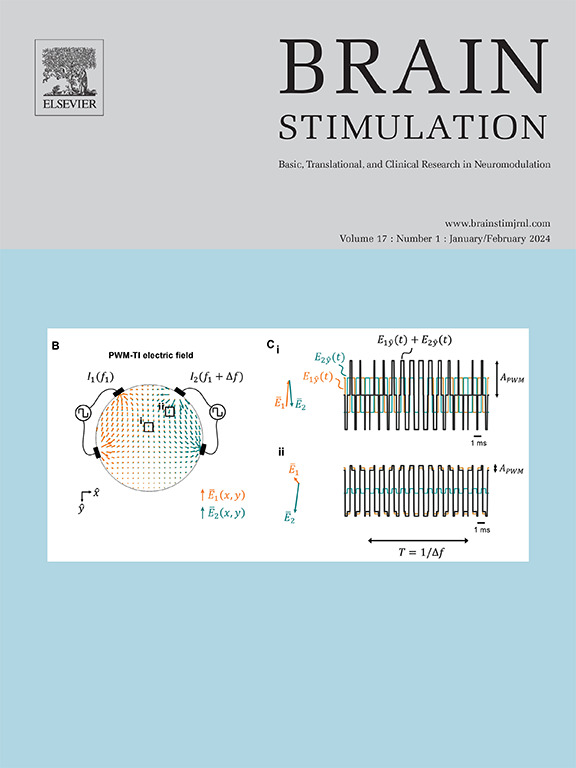静音 TMS 线圈可降低听觉感知和大脑反应。
IF 7.6
1区 医学
Q1 CLINICAL NEUROLOGY
引用次数: 0
摘要
背景:经颅磁刺激(TMS)线圈中的电磁力会产生巨大的咔嗒声,这种声音会干扰听觉激活,并对听力造成潜在危害。为了减少这种噪音,同时保持与传统 TMS 线圈相似的刺激效率,我们之前开发了一种安静的 TMS 双容纳线圈(qTMS-DCC):比较 qTMS-DCC 和商用 TMS 线圈的刺激强度、感知响度和脑电图反应:九名健康志愿者参与了一项受试者内研究设计。测量了 qTMS-DCC 和 MagVenture Cool-B65 的静息运动阈值 (RMT)。心理声学滴定法将 Cool-B65 的响度与 qTMS-DCC 脉冲的 80%、100% 和 120% RMT 匹配。两个线圈都记录了事件相关电位(ERP)。心理声学滴定和 ERP 是在线圈位于头皮上和离开头皮 6 厘米的情况下获得的,后者将空气中的听觉刺激与身体声音和电磁刺激的影响隔离开来。ERP比较主要集中在中央额叶区域,该区域包含了整体信号的峰值反应,同时刺激了初级运动皮层:qTMS-DCC被认为比Cool-B65安静得多。例如,线圈特定 RMT 为 100% 的 qTMS-DCC 听起来就像 RMT 为 34% 的 Cool-B65。两个线圈的总体ERP波形和地形相似,早衰分量也相似,这表明在头皮状态下的电磁脑刺激效果相当。在头皮状态和非头皮状态下,qTMS- DCC的P180分量都明显较小,这证明听觉激活减少了:结论:qTMS-DCC 的刺激效率与 Cool-B65 相当,而感知响度和听觉诱发电位却大大降低。本文章由计算机程序翻译,如有差异,请以英文原文为准。
Reduced auditory perception and brain response with quiet TMS coil
Background
Electromagnetic forces in transcranial magnetic stimulation (TMS) coils generate a loud clicking sound that produces confounding auditory activation and is potentially hazardous to hearing. To reduce this noise while maintaining stimulation efficiency similar to conventional TMS coils, we previously developed a quiet TMS double containment coil (qTMS-DCC).
Objective
To compare the stimulation strength, perceived loudness, and EEG response between qTMS-DCC and a commercial TMS coil.
Methods
Nine healthy volunteers participated in a within-subject study design. The resting motor thresholds (RMTs) for qTMS-DCC and MagVenture Cool-B65 were measured. Psychoacoustic titration matched the Cool-B65 loudness to qTMS-DCC pulsed at 80, 100, and 120 % RMT. Event-related potentials (ERPs) were recorded for both coils. The psychoacoustic titration and ERPs were acquired with the coils both on and 6 cm off the scalp, the latter isolating the effects of airborne auditory stimulation from body sound and electromagnetic stimulation. The ERP comparisons focused on a centro-frontal region that encompassed peak responses in the global signal while stimulating the primary motor cortex.
Results
RMT did not differ significantly between the coils, with or without the EEG cap on the head. qTMS-DCC was perceived to be substantially quieter than Cool-B65. For example, qTMS-DCC at 100 % coil-specific RMT sounded like Cool-B65 at 34 % RMT. The general ERP waveform and topography were similar between the two coils, as were early-latency components, indicating comparable electromagnetic brain stimulation in the on-scalp condition. qTMS- DCC had a significantly smaller P180 component in both on-scalp and off-scalp conditions, supporting reduced auditory activation.
Conclusions
The stimulation efficiency of qTMS-DCC matched Cool-B65 while having substantially lower perceived loudness and auditory-evoked potentials.
求助全文
通过发布文献求助,成功后即可免费获取论文全文。
去求助
来源期刊

Brain Stimulation
医学-临床神经学
CiteScore
13.10
自引率
9.10%
发文量
256
审稿时长
72 days
期刊介绍:
Brain Stimulation publishes on the entire field of brain stimulation, including noninvasive and invasive techniques and technologies that alter brain function through the use of electrical, magnetic, radiowave, or focally targeted pharmacologic stimulation.
Brain Stimulation aims to be the premier journal for publication of original research in the field of neuromodulation. The journal includes: a) Original articles; b) Short Communications; c) Invited and original reviews; d) Technology and methodological perspectives (reviews of new devices, description of new methods, etc.); and e) Letters to the Editor. Special issues of the journal will be considered based on scientific merit.
 求助内容:
求助内容: 应助结果提醒方式:
应助结果提醒方式:


